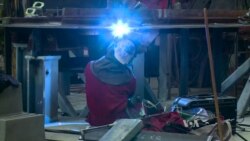The United States has lost millions of manufacturing jobs in recent years.
Some American businesses have turned to robots or other machines to do manufacturing work once performed by humans. Trade agreements are believed to be another reason for the job loss.
Most of these positions no longer exist. That leaves many Americans unemployed or in jobs with low pay and little chance for better wages.
At the same time, some companies say they have good-paying jobs but cannot find workers with the skills needed to perform them.
Many companies in other countries have apprenticeship programs to train workers, but most American companies do not. Apprenticeships often combine classroom training with practical work experience. Over a few years, a worker slowly gains the skills needed to perform complex jobs.
But a large American company is using apprenticeships to develop a high-tech workforce. That company is Newport News Shipbuilding in the eastern state of Virginia.
Jordan Lacy is in the first year of his apprenticeship at Newport News Shipbuilding. He is joining parts of a nuclear-powered attack submarine.
“It starts as a pile of pieces. When it leaves, it is a finished unit.”
Lacy has also helped build a nuclear-powered aircraft carrier.
Newport News Shipbuilding has been training apprentices for almost 100 years in the many skills needed to build modern warships.
"How about a machinist, what does a machinist do?”
Lacy is also learning other skills in class. He works in the company’s shipyard a few days a week, then attends classes. He wants to learn how to design ships, not just assemble them.
The Apprentice School at Newport News Shipbuilding has more than 700 students. They are all receiving wages from the company. In other words, they are being paid to learn.
Everett Jordan started as an apprentice. He is now the school’s director of education.
“I think it’s an education with a purpose, really.”
Jordan says combining classroom education and work-related training creates the workers the company needs.
“That graduate has been down in the tanks, the bowels of these ships, they know these complex plates and assemblies, they know what it takes to be a test electrician, they’ve done it and they take that experience with them the rest of their career.”
Edward Alden has written a book called “Failure to Adjust.” It tells about problems in the American workforce. He says apprenticeships are more common in Germany, Denmark and other countries than the United States.
“Apprenticeships are essentially an investment by companies in their future, and in the future of their communities. And we saw over the decade of the 2000s a 40 percent decline in apprenticeships being offered by private companies.”
Everett Jordan says apprenticeships could help many Americans who once worked in manufacturing positions. His school offers 19 basic programs and many advanced classes for workers who show strong skills and ability.
Elise Feldt is one of his students.
“I love what I do and I think the best part about it is the problem solving and having to learn and understand so much of what I’m getting into.”
The shipyard has about 20,000 workers. Three-thousand of them attended the apprentice school.
I’m Marsha James.
VOA Correspondent Jim Randle reported this story from Newport News, Virginia. Christopher Jones-Cruise adapted the story for Learning English. George Grow was the editor.
We want to hear from you. Write to us in the Comments Section, or visit our Facebook page.
_____________________________________________________________
Words in This Story
practical – adj. real, as opposed to theoretical or something taught in a classroom; relating to what can or should be done in an actual situation
pile – n. a group of things that are put one on top of another or in one area
unit – n. a set of similar pieces of something that are attached or joined
assemble – v. to connect or put together the parts of something, such as a machine
bowels – n. the deep inner areas of a place
adjust – v. to change in order to work or do better in a new situation








